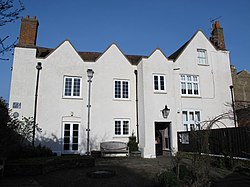Place House, Ware: Difference between revisions
Created page with "{{Infobox house |name=Place House |county=Hertfordshire |picture=Place House, Bluecoat Yard (geograph 4362573).jpg |picture caption=Place House |os grid ref=TL35921436 |latitu..." |
No edit summary |
||
| Line 7: | Line 7: | ||
|latitude=51.811356 | |latitude=51.811356 | ||
|longitude=-0.029764692 | |longitude=-0.029764692 | ||
|town=Ware | |||
|type=Town house | |type=Town house | ||
|address=Bluecoat Yard | |address=Bluecoat Yard | ||
Latest revision as of 20:26, 25 March 2019
| Place House | |
| Hertfordshire | |
|---|---|
 Place House | |
| Location | |
| Grid reference: | TL35921436 |
| Location: | 51°48’41"N, 0°1’47"W |
| Town: | Ware |
| History | |
| Address: | Bluecoat Yard |
| Built 13th / 14th century | |
| Town house | |
| Information | |
| Owned by: | Hertfordshire Building Preservation Trust and private owners |
| Website: | placehousehall.org |
Place House is a mediæval courtyard house in the centre of Ware in Hertfordshire, which was once the manor house of Ware. It has since been divided, but the mediæval core of the building, known as 'Place House Hall', is now owned by the Hertfordshire Building Preservation Trust, who have restored it. It is now hosts public functions.
The building is one of the most important early mediæval timber-framed structures in the county.
Place House stands in a small walled courtyard. It is a Grade I listed building.[1] The oldest part of the building, the original part of the mediæval house, is an aisled hall and cross passage which stands at the core of the building, and is thought to date to the late 13th or early 14th century when the manor was held by Thomas Wake, the Second Lord of Lydell (b.1297 - d.1349). It is this part which is now known as Place House Hall. The Hertfordshire Building Preservation Trust acquired the hall in 1975 and oversaw its restoration in 1977-8.
The remainder of Place House is in private use as self-contained offices and residential accommodation.
History
The house is believed to have been built in the ate 13th century, and to have been altered and extended in the late 15th or early 16th centuries, with further changes in later centuries. After the Trust acquired the building it was restored, between 1977 and 1978 (under the supervision of Gilbert Williams.
Ware Manor was held by Hugh de Grentmesnil in 1086 and Place House was probably built during the tenure of John Wake (1285-1300). Amongst later owners were Joan of Kent, the widow of the Black Prince and mother of King Richard II, who held the Manor between 1352 and 1384. King Henry VII granted the manor to his mother, Margaret Beaufort, Countess of Richmond. At some point between 1575 and 1587 the Manor was acquired by Thomas Fanshawe, who leased the Manor House out. A later tenant of the house, Humphrey Packer, may have rebuilt the east wing in the 17th century.
In 1685, Christ's Hospital acquired the property with the remainder of Bluecoat Yard and remodelled Place House by demolishing the west wing, adapting the hall as a large classroom by extending it northwards, demolishing the north aisle. The south aisle was heightened to two storeys and the corner fireplaces were added. The east wing was adapted as the schoolmaster's house. The Bluecoat School at Ware closed in 1761. (An upper floor inserted in the schoolroom in the late 18th century was removed in 1977.) Place House was a school again in the Victorian Age, until about 1880. Thereafter it deteriorated until its acquisition by the Hertfordshire Building Preservation Trust, and after restoration it was re-opened in 1978 by HM Queen Elizabeth the Queen Mother.
Structure
In structure it is a two-storey timber-framed building, plastered, pebble-dashed and colourwashed, and in parts with red brick casing. It has multiple tiled gables. The aisled hall is of two bays, with a cross passage and service wing to the east.
To the basic two storeys there are also attics above service wing (now part of the separate premises into which the house has been divided). The south front has a recessed entry beneath heavy late 13th century timber arch, with a 17th century gabled porch above. The complexity of the various elevations, with gables and windows from a variety of ages, testifies to the long history of the house.
The west elevation faces Bluecoat Yard (named form the school which formerly owned Place House) and again this shows a mixtures of work.
The major element of Place House is the aisled hall, of two unequal bays, with spere truss and screens passage to the east. The roof is supported with arch-braced tie-beams with intermediate struts (part restored in 1977). There is a crown post roof, with central octagonal crown post. Amongst the moulded bases and caps of the pillars are those carved with pomegranates and Tudor roses: the half-rose with half-pomegranate was a badge used by Queen Mary I, the Lady of the Manor in 1550. Corner fireplaces were inserted in the late 17th century, when the building was adapted by Christ's Hospital for use as Bluecoats School.[1]
Outside links
References
- ↑ 1.0 1.1 National Heritage List 1275417: Place House, Ware